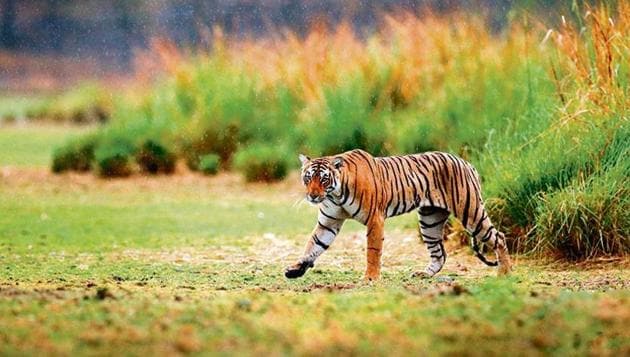10 Pilibhit tigers living in fields may be relocated
The effort is to minimise the danger of human-animal conflict in an area where human casualties are among the highest in the vicinity of a wildlife sanctuary in India.
The Uttar Pradesh forest department has given in-principle approval to a plan to relocate 10 tigers that have made the sugarcane fields outside the Pilibhit Tiger Reserve their home. The effort is to minimise the danger of human-animal conflict in an area where human casualties are among the highest in the vicinity of a wildlife sanctuary in India.

If the proposal gets the go-ahead from the National Tiger Conservation Authority (NTCA), it would be first tiger relocation in recent decades carried out with the specific intent of reducing the odds of the big cats coming into conflict with humans.
Last year, 49 people were killed by tigers, 18 more than the number reported in the previous year, according to information tabled in the budget session of Parliament. Since 2014, a total of 275 people have been killed by tigers, which have lost 60 of their own in conflict with humans during the same period
Pilibhit Tiger Reserve is among the wildlife habitats in India that has reported the highest number of human casualties. Twenty seven people have been killed by tigers since November 2016 in and around the 730 square kilometre reserve, home to up to 70 tigers.
The tiger population inside the horseshoe-shaped reserve is at the saturation level, prompting 10 of the big cats to make their home in the sugarcane fields in the vicinity. Tigers are territorial animals and the stronger felines tend to push the weaker and older ones out of their core area, forcing them to look for a new home.
“At least 10 tigers have made the sugarcane fields owned by some rich farmers near Deuni dam in Pilibhit’s Amaria block, 18 kilometres from Pilibhit Tiger Reserve, their home,” said Naveen Khandelwal, deputy director of the reserve. “The presence of the big cats outside the reserve area poses a bigger danger to people in the region which already has high man-animal conflict incidents.”
Because the tigers were outside the reserve’s boundary, they needed to be shifted back into the reserve. “Since we already have a dense tiger population, we sent a request to the authorities for relocating them to other safe sanctuaries,” he said.
The proposal to relocate the tigers has been approved in principle by the state government, said H Rajamohan, director of the reserve.
“We will work out a plan to shift them very soon with the technical help of the Wildlife Institute of India (WII) and Kanha Tiger Reserve in Madhya Pradesh,” Rajamohan said, adding that the UP forest department was looking at the Sohagi Barwa Wildlife Sanctuary in Maharajganj district as a possible new home for the 10 tigers.
Animal rangers plan to capture two tigers at a time before the proposed relocation. The captured tigers will be kept in special enclosures — one each in a 15-hectare area in Mala and Mahof forest ranges — for a period of at least two years to get them to acclimatise to their new surroundings.
“Due to a space crunch, we will be able to trap only two Amaria tigers at a time,” said Rajamohan.
After two years, the tigers will be fitted with radio collars, translocated and released in new locations that are environmentally similar to the Terai belt of Uttar Pradesh.
“The aim is to ensure that they do not come in contact with any human being and the imprint of human contact is wiped from their memory,” Rajamohan said.
Wildlife experts, however, aren’t sure about the soundness of the idea. Rahul Shukla, former honorary wildlife warden of Dudhwa reserve, for one, thinks it is a bad idea for two reasons.
“First, as the tigers living in the sugarcane fields have changed their prey consumption, they may not be able to survive in the wild. Second, these tigers (which are not man-eaters) may kill humans as they would find killing people easier; they will not have the ability to kill wild prey,” he said.
Shukla pointed to a previous attempt to shift a tiger from a sugarcane field in Pilibhit in 1997. “One week after we shifted the tigress to a forest in Bahraich, she was back near the sugarcane fields, preying upon chickens and sleeping near the fields, but she did not kill humans,” he said.
“Only problem tigers should be captured as most tigers may live in harmony with people. If good tigers are removed then new tigers will take their place and those may not live in harmony with people, creating more conflict,” said YV Jhala, senior scientist at WII. “Also, Sohagi Barwa does not have a prey base to support tigers currently. First this needs to be built up and tigers reintroduced subsequently.”
Get Current Updates on India News, Narendra Modi Live Updates, Arvind Kejriwal News Live, Election 2024 along with Latest News and Top Headlines from India and around the world.



